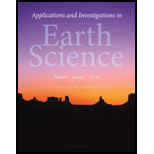
Write a statement or two describing the movement of water through the hydrologic cycle, including several of the processes that are involved.
The movement of water through the hydrologic cycle that includes the various processes.
Introduction:
Transpiration is the process through which moisture is carried by plants from roots to small pores on the underside of leaves. Here, it changes to vapor and is released to the atmosphere.
Explanation of Solution
The hydrologic cycle starts with the evaporation of water from the surface of the ocean. When this water vapor cools and condenses to form clouds, it will come on the earth’s surface in the form of rainwater. The groundwater either seep into the oceans or reversed back to the atmosphere through the process of evaporation.
The water in the hydrologic cycle includes various processes such as evaporation, transpiration, condensation, precipitation, and runoff.
Want to see more full solutions like this?
Chapter 4 Solutions
Applications and Investigations in Earth Science (8th Edition)
Additional Science Textbook Solutions
Campbell Biology in Focus (2nd Edition)
Campbell Essential Biology (7th Edition)
Laboratory Experiments in Microbiology (12th Edition) (What's New in Microbiology)
Microbiology: An Introduction
Chemistry: An Introduction to General, Organic, and Biological Chemistry (13th Edition)
Microbiology: An Introduction
- 41) Alpine glaciers A) are the largest types of glaciers. B) conform to the shape of the landscape. C) cover large sections of continents. D) show no relationship with the underlying topography.arrow_forward39) Translatory waves A) are the types of waves located furthest away from the shore. B) are slowed down by friction with the bottom of the ocean. C) move water particles in perfectly circular orbits. D) do not interact with the bottom of the ocean.arrow_forward38) The amount of sediment transported in a river depends on A) the discharge volume of water. B) temperature and precipitation. C) climate and topography. D) the length of the river.arrow_forward
- 45) The roughness layer refers to A) the atmospheric layer where wind has the fastest velocities. B) the layer of active weather between the stratosphere and the surface. C) the shallow layer of nearly still air. D) the layer of the atmosphere where dust storms occur.arrow_forward47) Deflation is the process by which A) wind transports smaller particles leaving behind only larger pebbles and rocks. B) sands are deposited closer to the source area and silts are deposited farther. C) sand dunes migrate downwind as sand saltates up the windward face. D) rocks are worn away by bombardment of particles carried in Windstream.arrow_forward46) In Barchan dunes, the slip face is oriented A) on the convex side of the dunes. B) parallel to wind direction. C) on the concave side of the dunes. D) at varying angles.arrow_forward
- 43) Glacial abrasion is when A) boulders are fragmented into smaller particles under the weight of the overlying ice. B) blocks of rocks are plucked from the underlying bedrock. C) rocks are carried at the base of a glacier and grind away at the underlying bedrock. D) debris fall onto the top of the glacier and are carried down glacier.arrow_forward34) Which of the following is true of soils? A) Soils rich in mineral matter are usually dark in colour. B) They usually require hours or days to form. C) Their development is affected by climate and organisms. D) Their properties are not affected by the type of rock from which they form. E) Older soils usually have fewer horizons than younger soils.arrow_forward44) In periglacial environments, the layer of ground that thaws every summer and freezes every winter is called A) frost layer B) permafrost C) active layer D) discontinuous permafrostarrow_forward
- 42) The ablation zone of a glacier A) has a total positive mass balance. B) is where snow accumulates and transforms into ice. C) is located in the upper part of the glacier. D) is where ice mass is lost.arrow_forward41) Alpine glaciers A) are the largest types of glaciers. B) conform to the shape of the landscape. C) cover large sections of continents. D) show no relationship with the underlying topography.arrow_forward40) Marine terraces are the result of A) coastal emergence through uplift or sea level decrease. B) coastal submergence through erosion or sea level increase. C) deposition of sands by the longshore current. D) wave refraction causing a loss of energy that allow sediments to be deposited.arrow_forward
 Applications and Investigations in Earth Science ...Earth ScienceISBN:9780134746241Author:Edward J. Tarbuck, Frederick K. Lutgens, Dennis G. TasaPublisher:PEARSON
Applications and Investigations in Earth Science ...Earth ScienceISBN:9780134746241Author:Edward J. Tarbuck, Frederick K. Lutgens, Dennis G. TasaPublisher:PEARSON Exercises for Weather & Climate (9th Edition)Earth ScienceISBN:9780134041360Author:Greg CarbonePublisher:PEARSON
Exercises for Weather & Climate (9th Edition)Earth ScienceISBN:9780134041360Author:Greg CarbonePublisher:PEARSON Environmental ScienceEarth ScienceISBN:9781260153125Author:William P Cunningham Prof., Mary Ann Cunningham ProfessorPublisher:McGraw-Hill Education
Environmental ScienceEarth ScienceISBN:9781260153125Author:William P Cunningham Prof., Mary Ann Cunningham ProfessorPublisher:McGraw-Hill Education Earth Science (15th Edition)Earth ScienceISBN:9780134543536Author:Edward J. Tarbuck, Frederick K. Lutgens, Dennis G. TasaPublisher:PEARSON
Earth Science (15th Edition)Earth ScienceISBN:9780134543536Author:Edward J. Tarbuck, Frederick K. Lutgens, Dennis G. TasaPublisher:PEARSON Environmental Science (MindTap Course List)Earth ScienceISBN:9781337569613Author:G. Tyler Miller, Scott SpoolmanPublisher:Cengage Learning
Environmental Science (MindTap Course List)Earth ScienceISBN:9781337569613Author:G. Tyler Miller, Scott SpoolmanPublisher:Cengage Learning Physical GeologyEarth ScienceISBN:9781259916823Author:Plummer, Charles C., CARLSON, Diane H., Hammersley, LisaPublisher:Mcgraw-hill Education,
Physical GeologyEarth ScienceISBN:9781259916823Author:Plummer, Charles C., CARLSON, Diane H., Hammersley, LisaPublisher:Mcgraw-hill Education,





